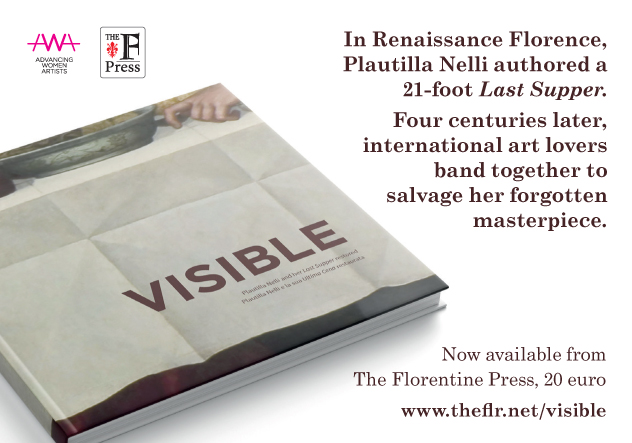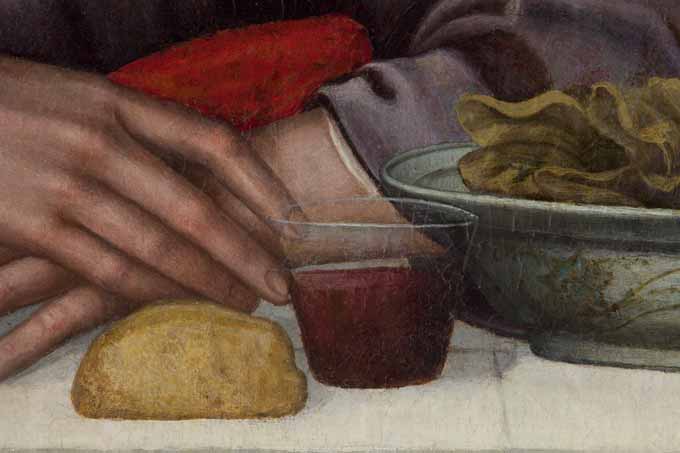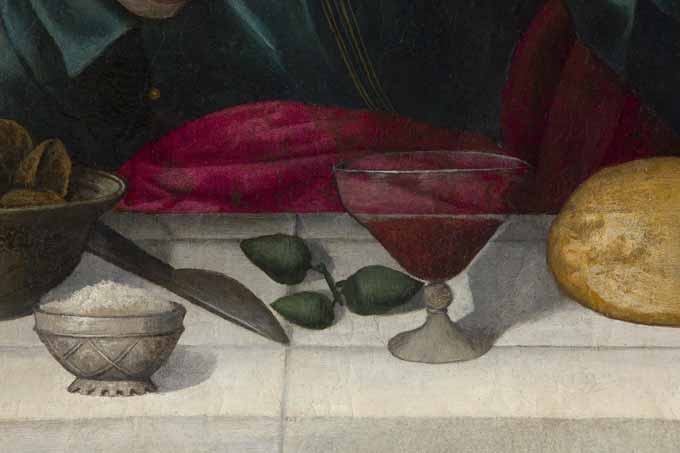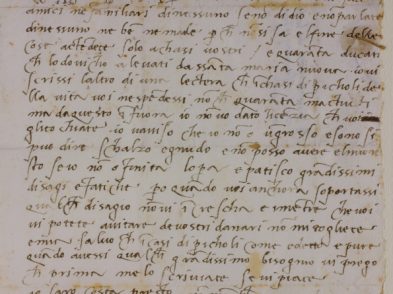On October 16, the afternoon before Nelli’s Last Supper was put on public view, I met with a friend of “old date”, as Italians would say. My amica di vecchia data did not even blink when I told her I was suffering from a new form of “postpartum depression”: the 21-foot painting had been moved to the Santa Maria Novella Museum and this left the conservation studio gapingly empty. Kathryn Rakich is good at taking my unexpected sorrow in stride. Diplomacy is her profession.
Under restoration for four long years, the Last Supper is the “jewel in the crown” of more than a decade of Nelli restorations that Advancing Women Artists and its founder Jane Fortune have supported in Florence. The work provided the backbone for the Uffizi’s Nelli exhibition in 2017, but to me, it has done more than that; it has bridged the gap of centuries by bringing the past and the future together, something that can only happen when people react to something that needs saving.
“It all ends tomorrow, with the unveiling,” I tell my friend.
Kate shakes her head. “No, it doesn’t. Tomorrow it begins. Nelli will be like Elizabeth Barrett Browning at the English cemetery.”
“What do you mean?”
“People from all over the world come to Browning’s grave in Florence, as if on a pilgrimage and leave her a rose. The same is going to happen with Nelli—the whole world will come and see her, and it will be a pilgrimage too.”
The next day, Nelli’s restoration was presented in the Basilica of Santa Maria Novella. Standing before hundreds who made the project possible, it seemed fitting to reflect on Florence’s traditional relationship with art supporters, as captured in Masaccio’s nearby Holy Trinity—the first-ever fresco in which patrons were featured alongside sacred characters. Ghirlandaio’s frescoes, also just steps from the altar, would do the same a few years later. The most successful bottega in Florence shocked (and pleased) the powerful by including then-contemporary Florentines on the biblical stage. Those works represent the birth of a Renaissance concept: art can merge the divine and the human. In some ways, the Nelli restoration reflects that same principle, because the painting was conceived as devotional work, but only the commitment of today’s art lovers has made it a work of devotion.
Since our conversation, Kathryn’s words continue to ring inside me like clear basilica bells… Who will be the first to bring a rose in honor of Nelli’s achievement?
There is no telling. I only know the first person to arrive with any sort of flower will be sent away—because being sent away is the very first step in the process called awareness. Both Plautilla Nelli and Jane Fortune taught me that, with five hundred years between them.
Helen Farrell, The Florentine’s editor-in-chief, invited me to write this article “to offer insight” on how I feel about concluding a restoration that has meant so much to so many across the world.
My insight, if you are kind enough to call it that, can be compressed into a single question: What will the museum staff do with so many roses?
As Kathryn says, the art-loving public will come—for we are the ones Nelli was addressing in the inscription below her signature, “Pray for the paintress”. And when we look up at Nelli’s masterwork in the museum, we will somehow join the daily and the divine just as Masaccio did. So, the restoration begins here, with Nelli high on the wall, because I believe in a world like the kind Ghirlandaio conjured—where patrons and painterly figures share the same space. And I hope Nelli’s canvas will expand to include each and every one of us—teeming players on the Florence stage of today and yesterday.
It is time to celebrate. A masterful painting by the city’s first female artist is newly restored and so should we be. Shakespeare can sum up the reason: The fragrance always lingers on the hand that gives the rose.
What it takes to be ‘VISIBLE’
Book presentation and author’s conference
At 5.30pm on Tuesday, November 12, Santa Maria Novella’s Infopoint (piazza Stazione 5, Florence) is hosting the presentation of the restoration catalog Visible: Plautilla Nelli and her Last Supper restored, AWA’s latest publication with historic partners The Florentine Press. Authors Silvia Colucci, Rossella Lari, Linda Falcone, Francesco Morena, Silvia Ciappi, Donata Magrini and Susanna Bracci will be on site to share their research regarding the four-year project aimed at rescuing Nelli’s masterwork now on display at the Santa Maria Novella Museum. Here are some of the topics discussed: Diagnostic tests reveal the secrets of Nelli’s palette; the tension-filled moment Nelli represents, Judas as a central figure twinned with Saint John; what restoration tells us about the artist, porcelain and glassware on Nelli’s table; the painting’s “many lives” in Florence’s historic venues; how modern-day audiences responded to the painter’s plea. Admission is free, but booking is mandatory: linda@advancingwomenartists.org











